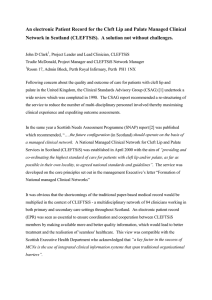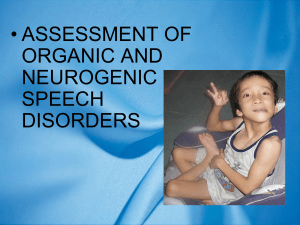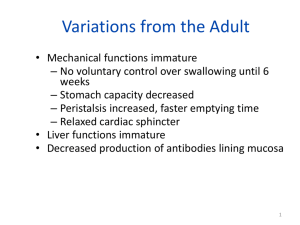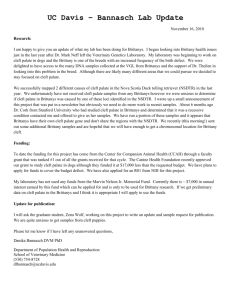Coding for Cleft Lip and Palate Surgery
advertisement
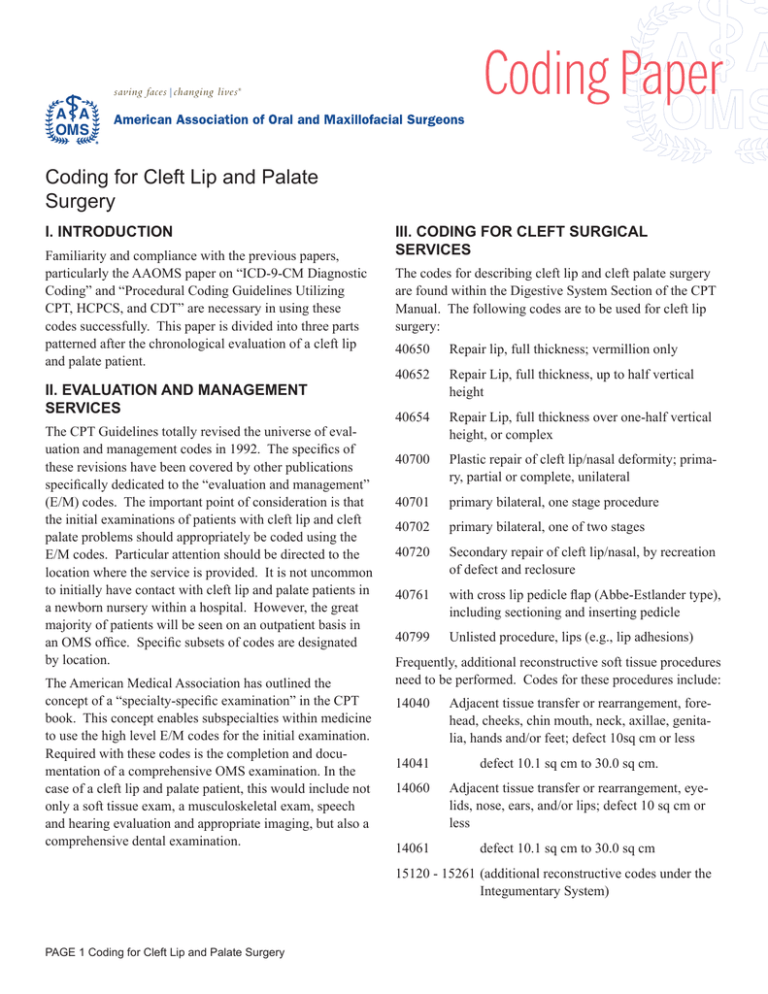
saving faces|changing lives ® Coding for Cleft Lip and Palate Surgery I. INTRODUCTION Familiarity and compliance with the previous papers, particularly the AAOMS paper on “ICD-9-CM Diagnostic Coding” and “Procedural Coding Guidelines Utilizing CPT, HCPCS, and CDT” are necessary in using these codes successfully. This paper is divided into three parts patterned after the chronological evaluation of a cleft lip and palate patient. II. EVALUATION AND MANAGEMENT SERVICES The CPT Guidelines totally revised the universe of evaluation and management codes in 1992. The specifics of these revisions have been covered by other publications specifically dedicated to the “evaluation and management” (E/M) codes. The important point of consideration is that the initial examinations of patients with cleft lip and cleft palate problems should appropriately be coded using the E/M codes. Particular attention should be directed to the location where the service is provided. It is not uncommon to initially have contact with cleft lip and palate patients in a newborn nursery within a hospital. However, the great majority of patients will be seen on an outpatient basis in an OMS office. Specific subsets of codes are designated by location. The American Medical Association has outlined the concept of a “specialty-specific examination” in the CPT book. This concept enables subspecialties within medicine to use the high level E/M codes for the initial examination. Required with these codes is the completion and documentation of a comprehensive OMS examination. In the case of a cleft lip and palate patient, this would include not only a soft tissue exam, a musculoskeletal exam, speech and hearing evaluation and appropriate imaging, but also a comprehensive dental examination. III. CODING FOR CLEFT SURGICAL SERVICES The codes for describing cleft lip and cleft palate surgery are found within the Digestive System Section of the CPT Manual. The following codes are to be used for cleft lip surgery: 40650 Repair lip, full thickness; vermillion only 40652 Repair Lip, full thickness, up to half vertical height 40654 Repair Lip, full thickness over one-half vertical height, or complex 40700 Plastic repair of cleft lip/nasal deformity; primary, partial or complete, unilateral 40701 primary bilateral, one stage procedure 40702 primary bilateral, one of two stages 40720 Secondary repair of cleft lip/nasal, by recreation of defect and reclosure 40761 with cross lip pedicle flap (Abbe-Estlander type), including sectioning and inserting pedicle 40799 Unlisted procedure, lips (e.g., lip adhesions) Frequently, additional reconstructive soft tissue procedures need to be performed. Codes for these procedures include: 14040 Adjacent tissue transfer or rearrangement, forehead, cheeks, chin mouth, neck, axillae, genitalia, hands and/or feet; defect 10sq cm or less 14041 14060 defect 10.1 sq cm to 30.0 sq cm. Adjacent tissue transfer or rearrangement, eyelids, nose, ears, and/or lips; defect 10 sq cm or less 14061 defect 10.1 sq cm to 30.0 sq cm 15120 - 15261(additional reconstructive codes under the Integumentary System) PAGE 1 Coding for Cleft Lip and Palate Surgery 15576 Coding Paper Formation of direct or tubed pedicle, with or without transfer; eyelids, nose, ears, lips, or intraoral Codes used to describe cleft palate surgery (Codes are located in the Digestive System heading under the Section of Palate and Uvula) to include the alveolus, anterior/posterior hard palate and soft palate, are as follows: naso-labial fistula is considered integral to the alveolar cleft repair). If you choose to repair of a naso-alveolar cleft and oral–nasal fistula of the posterior hard palate at the same time. Using 42210-59, 30600-59 (or 42200-59 as appropriate) is acceptable, if denied an appeal is justified. 42200Palatoplasy for cleft palate, soft and/or hard palate only 42205 Palatoplasty for cleft palate, with closure of alveolar ridge; soft tissue only 42210 Palatoplasty for cleft palate with bone graft to alveolar ridge (includes obtaining graft). This includes grafting from the alveolar crest to the piriform rim. • • • • Note 1: To report a bone graft to an alveolar cleft as a secondary procedure for ridge augmentation, without a palatoplasty, use code 21210. For example: a child had a successful alveolar graft at 9 years old, patient is now ready for a dental implant. Additional bone stock is needed to support the dental implant. Note 2: When a separate surgeon harvests the bone or other tissues through a separate skin incision use code 20902. See below Note 3: regarding bilateral clefts. The modifier -50 would logically apply, however, the Medicare, Medically Unlikely Edit (MUE) policy prohibits using the bilateral modifier with the 42210. Therefore; there is no distinction between repair of a unilateral and bilateral alveolar cleft and there is not a separate bilateral cleft code. You may consider using the -22 (unusual difficulty) modifier for bilateral clefts. Note 4: codes 42200, 42205, 42210, 30600 and 42260 cannot be used together as a result of the Correct Coding Initiative (CCI edits). However; it is appropriate to use the modifier -59, if the services are distinctly separate. For example, regarding a patient with a naso-alveolar cleft and a oronasal fistula of the posterior hard palate (repair of the naso-alveolar fistula extending into the anterior hard palate/premaxilla and the PAGE 2 Coding for Cleft Lip and Palate Surgery 41899 Extraction of teeth during cleft palate surgery. Specify difficulty with ICD-9/10 code. For example: removal of an impacted supernumerary tooth in the cleft (520.1) or removal of a decayed erupted primary incisor in the cleft (521.0). 42215 Palatoplasty for cleft palate; major revision 42220Palatoplasty for cleft palate, secondary lengthening procedure 42225Palatoplasty for cleft palate, attachment pharyngeal flap 42226Lengthening of palate and pharyngeal flap 42227Lengthening of palate, with island flap 42235Repair of anterior palate, including vomer flap 42260Repair of nasolabial fistula 20902 Bone harvest any area, major or large. Code used for obtaining autogenous bone or other tissues through a separate skin incision by a separate surgeon than performing the primary procedure. If the primary procedure “includes obtaining the graft” use the -52 modifier on the primary procedure for reduced services or both surgeons may report the primary procedure code appended by the -62 modifier. For example: surgeon #1 repairs a unilateral cleft: use 42210-52. Surgeon #2 harvest bone from the iliac crest and does not assist in the surgery: use 20902-62 30580 Repair fistula; oromaxillary (combine with 31030 if antrotomy is included) 30600Repair oral-nasal fistula Additional procedure codes include: 30400-30630 Rhinoplasty, septoplasty, nasal region repair codes Recommendations by the AAOMS Committee on Health Care and Advocacy (CHCA) for procedures used for treating patients with cleft lip and palate deformities for which there are no specific CPT codes: Coding Paper Prosthethetic devices used as adjuncts for cleft lip and palate treatment: 42280 42281 Maxillary impression for palatal prosthesis: Use 42280 for taking an impression in the office, you may choose to use the -22 modifier if the impression is made under anesthesia. Insertion palatal prosthesis: use 42281 if the prosthesis is fabricated by a laboratory (NOT by the provider) and delivered/inserted by the provider where limited adjustments are required. 21085Impression and custom preparation of oral surgical splint: The AAOMS CHCA does NOT recommend the use of this code for cleft palate prosthesis. This code should be used for provider fabricated splints in conjunction with orthognathic surgery. 21084Speech aid prosthesis 21076 Prepare facial/oral prosthesis: includes taking impression(s), custom preparation and delivery/ insertion for the prosthesis. It is assigned a 10 day global surgical package, therefore, Subsequent adjustments beyond 10 days may be billed with and E&M code. Pre-surgical Nasoalveolar moulding (NAM) best fits within this code Tongue Flap for closure of a large palatal fistula: 15576Tongue flap: anterior of posterior based pedicled flap. 21110 Application of intermaxillary fixation: MMF not in conjunction with facial fracture. 15600 Sectioning (division and inset) of the flap at the trunk: use this code when the tongue flap is “taken down” post-op. Includes plasty of the dorsal tongue and pedicle attached to the palate. The AAOMS Committee on Health Care and Advocacy recommends that the oral and maxillofacial surgeon use the CPT codes described for cleft lip and palate surgery rather than the American Dental Association’s Current Dental Terminology (CDT) codes. III. MODIFIERS FOR CLEFT LIP AND PALATE SURGERY The following code modifiers may have some application in the reporting of services for cleft lip and palate surgery. -50 Bilateral procedure -51 Multiple procedures -52 Reduced services -58 A planned, staged or related procedure/service by the same physician during the 90 day GSP postoperative period. -59 distinctly separate services -62 Two surgeons -66 Surgical team -80 Assistant surgeon IV. DIAGNOSIS CODING FOR CLEFT LIP AND PALATE SURGERY Correct usage of the CPT (procedural) and the ICD-9-CM (diagnosis) Coding Systems require that the appropriate ICD-9-CM codes be linked to the surgical procedures listed in the CPT universe. There is a great degree of specificity that has been built into the ICD-9-CM section under congenital anomalies to cover the spectrum of disorders associated with the cleft lip and palate deformity. The following fifth-digit of the ICD-9-CM codes are used to describe the different congenital anomalies: 749.0 Cleft Palate 749.00 Cleft palate, unspecified 749.01 Unilateral, complete 749.02 Unilateral, Incomplete 749.03 Bilateral, complete 749.04 Bilateral, incomplete 749.1 Cleft Lip (Cheiloschisis, harelip, congenital fisure of lip, and Labium leporinum) 749.10 Cleft lip, unspecified 749.11 Unilateral, complete PAGE 3 Coding for Cleft Lip and Palate Surgery 749.12 Unilateral, incomplete 749.13 Bilateral, complete 749.14 Bilateral, incomplete 749.2 Coding Paper Cleft Palate with Cleft Lip (Cheilopalatoschisis) 749.20 Cleft palate with cleft lip, unspecified 749.21 Unilateral, complete V. Global Surgical Package (GSP) 749.22 Unilateral, incomplete The global surgical package concept is in effect for the CPT codes used to describe cleft lip and palate surgery. It is defined by CPT that use of the procedure code on a claim form will cover one related E/M encounter on the date immediately prior to or on the date of the procedure (subsequent to the decision for surgery), the surgical care (the operation), and both post-operative care in the hospital and in the office. The global period of follow-up for cleft surgical services is generally 90 days. 749.23 Bilateral, complete 749.24 Bilateral, incomplete 749.25 Other combinations 750.2 Other Specified Anomalies of Mouth and Pharynx 750.25 Congenital fistula of lip Congenital (mucous) lip pits 520.1 Tooth codes pertinent to cleft palate codes 520.0 Congenital missing teeth 520.6 Impacted teeth, eruption disturbance 520.1 Supernumerary toot 520.3 Mottled teeth 520.1 Decayed teeth 521.6 Ankylosed tooth “V51 Aftercare involving the use of plastic surgery” should be used when applicable for reporting plastic surgery following healed injury or operation Note: This paper should not be used as the sole reference in coding. Both diagnosis and treatment codes change frequently, and insurance carriers may differ in their interpretations of the codes. Coding and billing decisions are personal choices to be made by individual oral and maxillofacial surgeons exercising their own professional judgment in each situation. The information provided to you in this paper is intended for educational purposes only. In no event shall AAOMS be liable for any decision made or action taken or not taken by you or anyone else in reliance on the information contained in this article. For practice, financial, accounting, legal or other professional advice, you need to consult your own professional advisers. This is one in a series of AAOMS papers designed to provide information on coding claims for oral and maxillofacial surgery (OMS). This paper discusses coding for Cleft Lip and Palate Surgery. This paper is to aid the oral and maxillofacial surgeon with proper diagnosis (ICD-9-CM) and treatment (CPT/CDT) coding for Cleft Lip and Palate Surgery. When indicated, you will be referred to the appropriate area of the coding books where the principles of coding illustrated in this paper may be applied. Proper coding provides a uniform language to describe medical, surgical, and dental services. Diagnostic and procedure codes are continually updated or revised. The AAOMS Committee on Health Care and Advocacy has developed these coding guidelines in order to assist the membership to use the coding systems effectively and efficiently. © 2013 American Association of Oral and Maxillofacial Surgeons. No portion of this publication may be used or reproduced without the express written consent of the American Association of Oral and Maxillofacial Surgeons. Revised March 2013 PAGE 4 Coding for Cleft Lip and Palate Surgery

